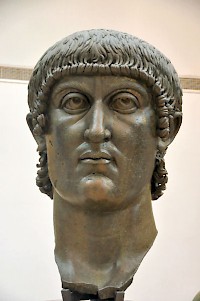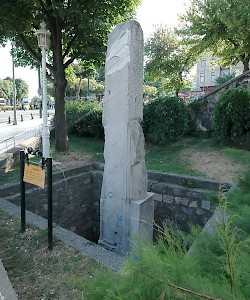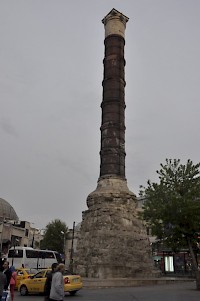Constantine's City
Constantinople (Κωνσταντινούπολις) or Byzantium (Βυζάντιον): Greek city on the Bosphorus, capital of the Byzantine Empire, modern İstanbul.

At the beginning of the fourth century, the Roman Empire was divided into four parts, ruled by four emperors, or tetrarchs, as they were called. One of them, Constantine, had in 312 defeated his nearest colleague, and had become master of the western half of the Mediterranean world. One year later, Licinius became sole ruler of the eastern half. It was inevitable that the two remaining emperors would clash, and this indeed happened on 18 September 324. Near Chrysopolis (east of the Bosphorus, opposite Byzantium), Constantine defeated Licinius; Constantine's son Crispus played a heroic role and received a monument in Byzantium in the shape of a marble warship.
Not much later, on Sunday 8 November 324, Constantine consecrated Byzantium as his new residence, Constantinoupolis, "city of Constantine". Licinius' treasure may have been used to finance the project, which was by no means unique: other tetrarchs had also founded new residences, like Galerius in Thessaloniki and Diocletian in Nicomedia. Nor was it something new that the city was named after the emperor himself. Not far to the northwest of Constantinople was Hadrianopolis. The founding ritual wasn't anything new either: although Christian officials were present, the usual team of pagan priests, astrologers, and augurs did the job. Whatever later historians, like Sozomenus, have said, Constantinople was not meant as the Empire's Christian capital.
For the time being, pagan Rome remained Constantine's capital, where he built many new monuments: his famous Arch, the churches of Saint Peter and Saint Paul, and his mausoleum (now called Santa Costanza). It was in Rome that the emperor celebrated his Vicennalia - his twenty-year jubilee. However, there were some riots during the festival, in 326, and at about the same time, there was a political crisis that led to the downfall of Crispus and Constantine's second wife Fausta. It must have been at this moment, almost two years after the consecration of Constantinople, that the emperor decided to leave Rome behind, and on Monday 4 November 328 new rituals were performed, now to dedicate the city as capital. Among the attendants were the Neoplatonist philosopher Sopater and pontifex maximus Praetextus.
By now, the new land walls, two kilometer west of the Severan walls, were finished. They had been built by 40,000 Gothic POWs and surrounded a city of about 6 km², situated on four hills that ran more or less parallel to the Golden Horn.
A year and a half later, on Monday 11 May 330, when the festival of Saint Mocius was celebrated, the city was finally dedicated. The goddess Tyche was invited to come and live in the city, and her statue was placed in the hand of the statue of the emperor that was on top of the Column of Constantine, on the Forum with the same name. Although by now Constantine openly supported Christianity, the city still offered room to pagan cults: there were shrines for the Dioscuri and Tyche. The Acropolis, with its ancient pagan temples, was left as it was. As for worshipping the emperor, Constantine's mausoleum gave him a Christ-like status: his tomb was between two times six sarcophagi, each containing relics of one of the Apostles. The emperor still claimed to be a supernatural being, although the outward form of this personality cult had become Christian.
Other things had changed as well. Christians did not appreciate gladiatorial contests, so the amphitheater was abandoned, although criminals were still executed over there. As a result, horse races became very popular, and fortunately, Constantine had expanded the hippodrome, so that it offered seats to about 30,000-40,000 people. To decorate it, the Serpent's Column was taken away from Delphi. Nor was this the only appropriation: elsewhere, the statues of Zeus of Dodona, Athena of Lindos, and Apollo of Delphi were to be seen. As the Christian author Jerome commented: "Constantine's city dedicated, remaining cities left naked".

To a large extent, the old, Severan city, was left intact. Tetrastôn Square, now called Augusteôn, was still the most important square in the city, although the Forum of Constantine, along the Mese, was becoming the economic center of Constantinople. The Baths of Zeuxippus had been expanded; a building for the town council (called Senate or Magnaura) had been added in the east; behind it was the new imperial palace, to which the Chalke gave access, a bronze gate with a statue of Constantine killing a sea dragon. The Milion, at the beginning of the Mese, was an arch-like monument inscribed with the distances to the main cities of the Empire. Close to it was a large underground cistern, now known as Binbirderek, the "Cistern of the 1001 Columns". But the most important new building was the still unfinished church for Divine Wisdom, the Hagia Sophia, built between the old church of Divine Peace and Augusteôn Square. The bishop had built his palace next to it, conveniently close to the palace of the emperor.

Walking to the west, one would soon climb to the circular Forum of Constantine on the second hill. Situated at the place where Mese had once crossed the walls of Severus, this forum was the city's market and commercial center. Among the monuments were a Senate building, a nymphaeum, and a structure called "tribunal", which may have been the seat of the mayor, who had the rank of proconsul. In the center was a column, hundred feet tall, made of nine porphyry drums brought from Heliopolis; on top of it was the statue of Constantine, holding a lance, a globe, and the statuette of Tyche in his hands. In the pedestal, important Christian and pagan relics were buried: baskets and remains of the loaves with which Jesus had once fed the multitude; the axe of Noah; Maria Magdalen's bottle of ointment; and the Palladium, the sacred statue of Athena that had, according to legend, once been in Troy and had been taken to Rome by Aeneas. This is the clearest proof that in Constantine's opinion Constantinople had, by now, really replaced Rome as capital of the world. The column survives.
Still continuing along the Mese to the west, one would reach the Forum Tauri ("forum of the bull"), south of the Third Hill; it is more or less identical to modern Beyazıt Square. Among the buildings were the Philadelphion - we have no ideas what it was - and a mysterious building called Capitol. It is certain that the famous porphyry statue of the four tetrarchs, now in the San Marco in Venice, once stood here.
A little bit further, the Mese split. Its northwestern branch continued to the Mausoleum of Constantine or Apostolion on the Fourth Hill, to Hadrianople, Serdica (modern Sofia), and the Danube. The other branch went to the southwest and is essentially the Via Egnatia, which continued to Amphipolis, Thessalonica, and the Adriatic Sea. Between these two branches was, outside the walls, the old church of Saint Mocius.
There was a lot of work for carpenters, masons, and other workers, who were living in the normal, five- or six-storied buildings, and received bread from the emperor; the official annona (corn dole) started in 332. Senatorial families were invited to come and live in the new city, and a few did. However, most senators preferred to stay in Rome, and a new senatorial order was created. It served as municipal council only; the Senate in Rome was still recognized as the only real body that could confer, on behalf of the entire Empire, legitimacy. The Roman senators were, as representatives of the whole world, called clarissimi, "most noble men", whereas the senators of the Constantinopolitean town council were just clari, "noblemen".
In 336, the city was ready. Constantine the Great could celebrate his Tricennalia, his thirty-year jubilee, in his new capital. One year later, he was baptised and died.